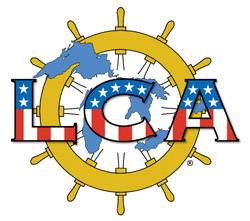U.S.-Flag Lakes Fleet Back to Work
Cleveland—The U.S.-flag Great Lakes fleet is returning to service to keep industrial America on the mend. The first vessel to get underway was the tug/barge unit DOROTHY ANN/PATHFINDER on March 5. The vessel will spend the month shuttling iron ore within Cleveland Harbor.
Next to sail was the cement carrier SAMUEL DE CHAMPLAIN/INNOVATION. The tug/barge unit left its winter berth in Cleveland on March 7 and sailed to Alpena, Michigan, where it loaded cement to resupply silos in Chicago.
The self-propelled laker JOSEPH L. BLOCK opened the season at Escanaba, Michigan, by loading an iron ore cargo bound for Indiana Harbor on March 15. Also that day the motor vessel MESABI MINER initiated the coal trade by loading a cargo in Superior, Wisconsin, for delivery to Marquette, Michigan.
More vessels will be getting underway in the days and weeks ahead, and many will time their departure with the March 25 opening of the locks at Sault Ste. Marie, Michigan.
U.S.-flag Great Lakes operators moved 93.8 million tons of cargo in 2011, an increase of 5.7 percent over 2010. This winter saw carriers spend more than $75 million at Great Lakes shipyards and repair facilities to maintain and modernize their vessels for the season just begun.
The U.S.-flag Lakes fleet is the largest assembly of self-unloading vessels in the world. The ships and tug/barge combinations are designed to discharge cargo without any assistance from shore side equipment or personnel and can unload as much 70,000 tons in ten hours or so.
Such innovations and efficiencies are threatened by the deepening dredging crisis on the Great Lakes. Years of insufficient Federal funding for dredging have left more than 17 million cubic yards of sediment clogging ports and waterways. Just last fall shipments to St. Joseph, Michigan, had to be suspended until emergency funds could be found to clear the harbor. A much-needed coal cargo for the power plant in Holland, Michigan, could not be delivered in December because of a build-up of silt in the harbor. Ships have been unable to deliver coal to Dunkirk, New York, since 2006 because of insufficient depth in the harbor.
It appears this year will hold more of the same. The Federal budget for 2012 will dredge only 16 of the 63 Federally-maintained ports on the Great Lakes. The Administration actually intended to dredge only 11 ports. But Congress increased the Corps budget and Senator Carl Levin (D-MI) added five ports back to the list.
Maintaining ports and waterways to project dimensions is critical to the viability of Great Lakes shipping and the industries it serves. The 56 vessels enrolled in Lake Carriers’ Association collectively forfeit more than 8,100 tons of cargo for each inch of reduced draft. The vessel owner is not the only one to suffer when cargo is left on the dock. Eighty-one hundred tons of iron ore represent eight hour’s production at a large mine in Minnesota or Michigan. That much iron ore would make the steel for 10,000 cars, enough work to keep an auto plant running 14 days straight.
Fluctuating and low water levels exacerbate the dredging crisis. But the forces of nature cannot be controlled. The dredging crisis, on the other hand, is entirely man-made. For the last 25 years, the Federal government has levied a nationwide tax on waterborne cargo to pay for dredging. The tax revenue is deposited in the Harbor Maintenance Trust Fund (“HMTF”). In a typical year, the HMTF takes in about $1.6 billion.
However, the government generally only spends about half of dredging tax receipts on dredging. The rest of the money is used to paper balance the budget. As a result, the surplus in the HMTF is expected to reach $7 billion by the end of FY12. The U.S. Army Corps of Engineers estimates that it needs $200














